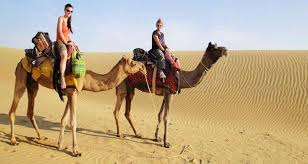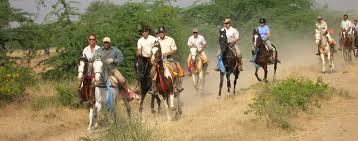Rajasthan invites you to feel the adventure of a Camel Safari, which takes you through the golden sands of the vast. Thar desert. Like horse safaris, camel safaris are also popular in Rajasthan. The camel, popularly known as the ship of the desert, is not only common in the Thar desert, but also the only means of transportation in remote areas. Ride through sandy tracks, passing through remote villages. Pitch your tent at a new place each night. Spend the evenings next to the camp tire and dance to the folk music.

The safari is organised to take one through the golden sands of the vast Thar desert and untamed countryside, enabling one to experience the days gone by when time drifted at a leisurely pace. The rolling landscape of the sand & shrub covered area is breathtakingly beautiful and the range of flora and fauna surprisingly large for a desert area. The camel breeders or Raika are the best guides. They know every pasture, waterhole and village of the region. One can ride or walk along leisurely with the safari and enjoy the deserts-cape. The camel-carts are fully equipped and tourists need not bother about comfort in the desert. camel safari can be arranged at Pushkar, jaisalmer or bikaner and also during nagaur fair,desert festival and Pushkar fair but without camel safari your journey to Rajasthan is not completed.
Rajasthan‘ – the land of the Rajputs, is known for its kings, fearless warriors and charming ladies. It is also known for its forts, palaces and temples which are a reminder of the glorious past. Kingdoms were carved and established by the Rajputs on horseback, while swords were stained with enemy blood.

Horses were highly priced and a Rajput warrior would give anything to own a good horse. Great care was taken to breed horses and to keep a clean and pure lineage. The result of many years of dedication and hard work helped create breeds like the Marwah, Kathiawadi and the sindhi, each having its own distinct characteristics and bred solely for the purpose of war. These horses were noted for their stamina and fierce loyalty to their masters, these gallant steeds, the Rajputs became famous worldwide.
Wildlife houses some of the best wildlife and bird sanctuaries in India. The most popular ones are Ranthambore National Park, Sariska Tiger Reserve, Keoladeo National Park, and Bharatpur Bird Sanctuary. Tigers, elephants, boars, bears, several species of birds, and various other inhabitants of the wild greet you to these wildlife sanctuaries.
Jaipur, the capital city of Rajasthan is well-known for its elephants in addition to the Elephant Safaris that it offers. These Elephant Safaris are one of the most thrilling ways for you to explore the countryside of the city of Jaipur. Most of these safaris will lead to the Amber Fort which is a private estate located in the green foothills.
Most of the Elephant Safaris on offer will venture though various villages where you will find the traditional village folk immersed in their everyday activities, the agricultural fields where farmers will toil hard to grow crops for their livelihood, majestic hills that dot the landscape of the countryside in addition to ancient monuments that have stood as a reminder of the glorious past of the great land of India.
The Bishnoi Village Jeep Safari is also a perfect way to tour the regions in and around the beautiful city of Jodhpur. Since the people belonging to the Bishnoi clan are eco-friendly people, one can find a variety of flora and fauna. The mix of lush greenery and wildlife is a perfect way to enjoy a vacation. The various wildlife safari and parks are a great place to discover the rich flora and fauna on offer. There will be an air-conditioned vehicle that will drop you from your hotel to a particular meeting point where a jeep will be waiting for you. The tour guides will brief you on the journey you will take. These Jeep Safaris will usually cover desert land, rocky areas and hills in a short span of time, saving you the effort of having to trek.
Rajasthan Budget Tour Packages
